Fagaras Mountains
If we had to put it in just a few words, than the Transfagarasan (DN 7C) is just the road that passes through Fagaras Mountains (the highest mountains in Romania – Moldoveanu peak – 2544 meters) and that connects Walachia and Transylvania. But in fact Transfagarasan road is more than that. It is the road that climbs to the highest altitude in Romania, 2042 meters, in the Glacial Hollow Balea.
 It has two traffic lanes of 92 kilometers long. Because of the countless turns, the average speed is maximum 40 km per hour. Along this route there are 27 viaducts and bridges, and the longest road tunnel in Romania – 887 meters, that passes through Paltin Mountains, from Capra to Balea Lake. The ventilation of the tunnel is made naturally, thanks to the extremely powerful currents. The traffic lane inside the unlighted tunnel is only 6 meters wide and there is a one meter broad pavement.
It has two traffic lanes of 92 kilometers long. Because of the countless turns, the average speed is maximum 40 km per hour. Along this route there are 27 viaducts and bridges, and the longest road tunnel in Romania – 887 meters, that passes through Paltin Mountains, from Capra to Balea Lake. The ventilation of the tunnel is made naturally, thanks to the extremely powerful currents. The traffic lane inside the unlighted tunnel is only 6 meters wide and there is a one meter broad pavement.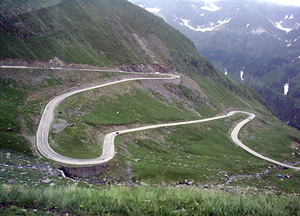
Transfagarasan road.
Tourists who would like to “venture” on the Transfagarasan Road are advised to climb it from South to the North. Romania’s most famous road runs from Arefu village (at km 61 of DN7C) in the county of Arges, to the county of Sibiu, somewhere near Cartisoara village (at the crossroad with DN1).
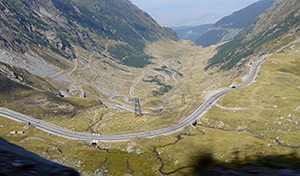
Transfagarasan road.
The landscape is fantastic, and the differences of altitude and the curves represent a challenge for both cars and drivers. Unfortunately, because of the weather conditions, Transfagarasan Road is opened for only a few months every year, usually from July until October.
The most important tourist attractions areVidraru Lake and Vidraru Dam, which is one of the greatest in Europe, thenPoenari Fortress (built in the time ofVlad Tepes), Balea Glacial Lake and Balea Waterfall.
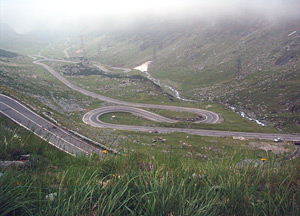
Transfagarasan road.
How it bas built
Transfagarasan was built between 1970 and 1974. A brief presentation with numbers might be difficult to follow, but for those who have the patience to read it is worth saying that about 3 million tones of hard rocks were dislocated, 830 transverse works and 290 000 cubic meters of masonry were made for building those 92 kilometers of road. For building the Capra – Balea Tunnel there were excavated over 41 000 cubic meters of rocks. There were also used 20 tones of dynamite, 3 573 tones of cement, 89 tones of concrete steel, 24 000 of anchors, 129 tones of brazed nets, 14 200 square meters of encasements, 1750 meters of concrete tubes, 4 100 meters of pipes, 50 tones of metal composites, 6 900 cubic meters of grit, 6000 cubic meters of gravel, 3 000 tones of crushed rocks and 740 lighting lamps.
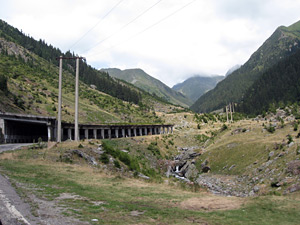
Tunnel on the Transfagarasan road.
Some of those who worked at the construction of Transfagarasan, nowadays retired, speak about the sacrifices that were made for the road that leads to the sky. Before its construction, it was impossible to cross the mountains, not even on horseback. But it is said that once, before becoming president, Nicolae Ceausescu stopped by Arefu village and the idea of a road that passed through the mountains crossed his mind. During the construction a lot of men lost their lives, like in Vidraru’s case. Unfortunately the documents didn’t keep these numbers. But the survivors say that it is about a hundred of human sacrifices. Many of those who died weren’t even found in the precipices in which they had fallen. It is also said that when the tunnel was built, the miners who were in charge with the planting of the explosive were hanging on each other, in groups of 20 or 30, not to be thrown by the strong wind into the precipice.
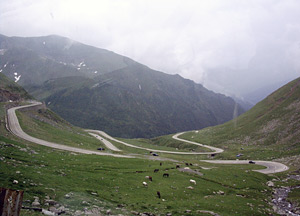
Fagaras Mountains – Transfagarasan road.
A story that has been spreading from mouth to mouth refers to a monk named Nectarie. After the construction of the Transfagarasan road, he climbed it by his car, a Trabant, up to Capra, where he was caught by an avalanche. He left the car at Capra, and he threw himself on the snow, being carried by the “wave”. It is said that he remained alive, while his car was found after 6 months, when the snow melt away.
Balea Waterfall and Balea Glacial Lake
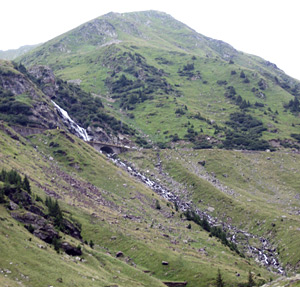
Balea Waterfall – Transfagarasan.
Balea Waterfall, located in the Fagaras Mountains, is one of the most famous waterfalls in Romania, is at an altitude of 1234 meters and the water falls from 68 meters.
Balea Glacial Lake is a real monument of nature (formed in a glacial circus), is 360 meters long, 240 meters broad and 11 meters depth. Situated at 2 034 meters of altitude, the lake is between the Defileul Oltului (Olt Canyon) and the foot of Piatra Craiului Mountains. It is accessible by car during the summer, and the rest of the year by a cable car from the “Balea Cascada” chalet.
Since 1932, the lake and about 180 hectare of land around it were declared scientific reservation. It must also be mentioned the fact that the first ice hotel in Eastern Europe was built near the lake in 2006.

Balea Lake Chalet and Balea Glacial Lake are located at an altitude of 2034 meters.
On summer one can practice boating on the lake, while on winter one can skate, play hockey or curling on the frozen surface of the lake. One can also climb down from the Waterfall by skiing, on a 10 kilometers route with a 600 meters difference of altitude.
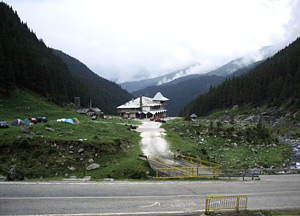
Paraul Capra Chalet – Transfagarasan.
Accommodation possibilities
There are many accommodation possibilities, from camping places to boarding houses and chalets. It is certain that booking must be done in advance because they are booked for the entire year.
“Valea cu Pesti” (Fish Valley) Chalet
Located on the East side of Vidraru Lake, at an altitude of 870 meters, the chalet was one of the protocol places used by Nicolae Ceausescu. Nowadays it has 18 dwellings, meaning 45 accommodation units.
Located on the East side of Vidraru Lake, at an altitude of 870 meters, the chalet was one of the protocol places used by Nicolae Ceausescu. Nowadays it has 18 dwellings, meaning 45 accommodation units.
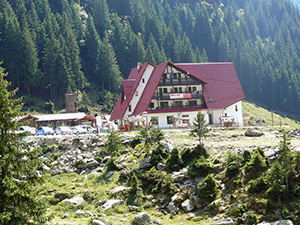
Complex Capra – Transfagarasan.
“Cumpana” (Sweep) Chalet
It is located on the West side of Vidraru Lake and has 88 accommodation units, a restaurant for 100 persons, a disco, a sport field, a pool that floats on Vidraru Lake on summer. One can also rent from here all sorts of amusement devices to use on the lake, and can take the passenger steamship (for 100 persons) that goes to Casa Argeseana (Argeseana House) and “Valea cu Pesti” (Fish Valley) Chalet.
It is located on the West side of Vidraru Lake and has 88 accommodation units, a restaurant for 100 persons, a disco, a sport field, a pool that floats on Vidraru Lake on summer. One can also rent from here all sorts of amusement devices to use on the lake, and can take the passenger steamship (for 100 persons) that goes to Casa Argeseana (Argeseana House) and “Valea cu Pesti” (Fish Valley) Chalet.
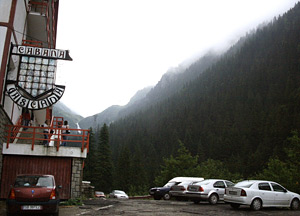
Cascada Chalet – Transfagarasan.
Dracula Boarding House
Dracula Boarding House is located on Transfagarasan route, at about 6 km far from Vidraru Dam and 1 km far fromPoenari Fortress. It has 20 rooms, parking lots, terrace, its own restaurant and bar.
Dracula Boarding House is located on Transfagarasan route, at about 6 km far from Vidraru Dam and 1 km far fromPoenari Fortress. It has 20 rooms, parking lots, terrace, its own restaurant and bar.
“Paraul Capra” Chalet
Capra Tourist Complex is located at an altitude of 1585 meters and has 52 accommodation units in 26 double rooms and a restaurant for maximum 80 persons.
Capra Tourist Complex is located at an altitude of 1585 meters and has 52 accommodation units in 26 double rooms and a restaurant for maximum 80 persons.
Cascada Chalet
It is located at the foot of the Balea Waterfall, at an altitude of 1234 meters. The chalet has 80 accommodation units, an all included restaurant, a day bar and, on demand, a conference room.
It is located at the foot of the Balea Waterfall, at an altitude of 1234 meters. The chalet has 80 accommodation units, an all included restaurant, a day bar and, on demand, a conference room.
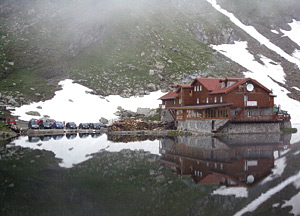
Balea Lake Chalet – Transfagarasan.
Balea Lake Chalet
Balea Lake Chalet is located on a half-isle that goes into the Balea Glacial Lake, at an altitude of 2034 meters. The present chalet was rebuilt in 2000, because the old one had been destroyed in a fire in 1995. On its three floors there are double rooms, rooms with four, six or ten places and also apartments. It has its own restaurant and facilities for renting sport equipment, baby sky and scooters.
Balea Lake Chalet is located on a half-isle that goes into the Balea Glacial Lake, at an altitude of 2034 meters. The present chalet was rebuilt in 2000, because the old one had been destroyed in a fire in 1995. On its three floors there are double rooms, rooms with four, six or ten places and also apartments. It has its own restaurant and facilities for renting sport equipment, baby sky and scooters.
Paltinul Villa
The villa is located on the border of the Balea Lake, at an altitude of 2044 meters, and has 26 accommodation units in double rooms, rooms of four and an apartment. One can also rent sport equipment, and professional mountain assistance is ensured as well.
One can also rent sport equipment, and professional mountain assistance is ensured as well.
The villa is located on the border of the Balea Lake, at an altitude of 2044 meters, and has 26 accommodation units in double rooms, rooms of four and an apartment.
 One can also rent sport equipment, and professional mountain assistance is ensured as well.
One can also rent sport equipment, and professional mountain assistance is ensured as well. Vidraru Dam
Vidraru Dam Carpathian Mountains
Carpathian Mountains Retezat National Park
Retezat National Park Romania Map
Romania Map



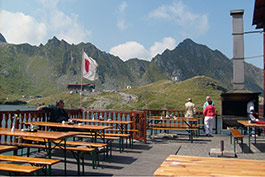
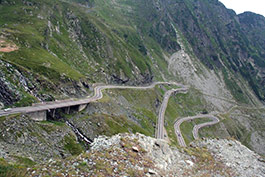
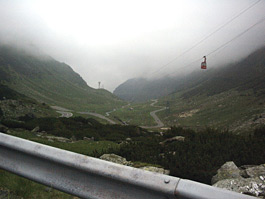
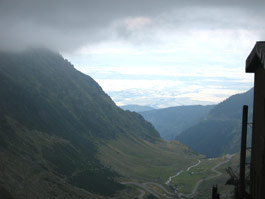
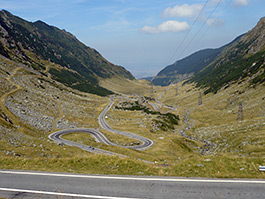
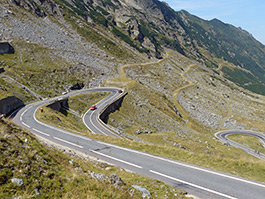
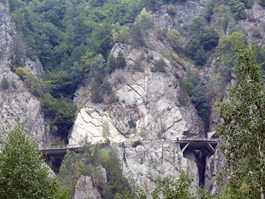
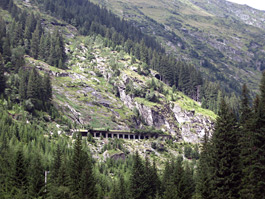
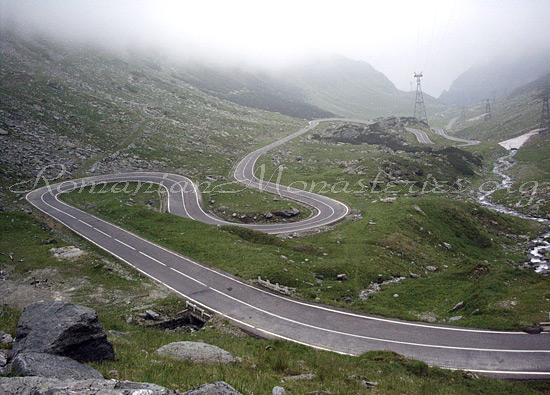
 The Transfagarasan shortly after it was completed
The Transfagarasan shortly after it was completed

















